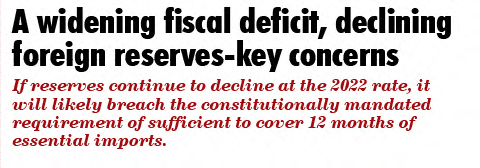𝑰𝒇 𝒓𝒆𝒔𝒆𝒓𝒗𝒆𝒔 𝒄𝒐𝒏𝒕𝒊𝒏𝒖𝒆 𝒕𝒐 𝒅𝒆𝒄𝒍𝒊𝒏𝒆 𝒂𝒕 𝒕𝒉𝒆 2022 𝒓𝒂𝒕𝒆, 𝒊𝒕 𝒘𝒊𝒍𝒍 𝒍𝒊𝒌𝒆𝒍𝒚 𝒃𝒓𝒆𝒂𝒄𝒉 𝒕𝒉𝒆 𝒄𝒐𝒏𝒔𝒕𝒊𝒕𝒖𝒕𝒊𝒐𝒏𝒂𝒍𝒍𝒚 𝒎𝒂𝒏𝒅𝒂𝒕𝒆𝒅 𝒓𝒆𝒒𝒖𝒊𝒓𝒆𝒎𝒆𝒏𝒕 𝒐𝒇 𝒔𝒖𝒇𝒇𝒊𝒄𝒊𝒆𝒏𝒕 𝒕𝒐 𝒄𝒐𝒗𝒆𝒓 12 𝒎𝒐𝒏𝒕𝒉𝒔 𝒐𝒇 𝒆𝒔𝒔𝒆𝒏𝒕𝒊𝒂𝒍 𝒊𝒎𝒑𝒐𝒓𝒕𝒔.
According to the Asian Development Outlook (ADO) April 2023, a widening fiscal deficit and declining foreign exchange reserves will remain key concerns for the government. If reserves continue to decline at the 2022 rate, it will likely breach the constitutionally mandated requirement that the reserves be sufficient to cover 12 months of essential imports.
As a small and import-dependent economy, Bhutan could face challenging tradeoffs if this problem persists. In the near term, higher hydropower output will likely sustain Bhutan’s exports and finances.
Moreover, the expected cessation of large information technology imports by mid-2023 is expected to keep the reserve position from deteriorating at such a rapid clip. At the same time, it is important that Bhutan continue to implement its medium-term strategy for debt management and the latest International Monetary Fund Article IV recommendations to reduce its debt: gradual fiscal consolidation, revenue mobilization, normalization of an accommodative monetary policy introduced in response to COVID-19, and addressing risks to banks, especially from a possible rise in nonperforming loans when pandemic relief measures expire.
However, the return to normal hydropower production after 2 years of decline will underpin growth in 2023, while expected production from two newly commissioned hydropower plants will help sustain growth in 2024.
As conservatively projected for these years, these plants are expected to raise GDP by 3 percentage points. As India is Bhutan’s main trade partner, its robust economic growth prospects in 2023 and 2024 will boost exports and growth. However, growth prospects are tempered this year and next by a marked decline in investment caused by emerging domestic macroeconomic issues, national elections in December 2023, and a transition to a new government five year plan. On balance, growth is projected to slow from 4.7 percent in 2022 to 4.6 percent in 2023 and 4.2 percent in 2024.
Despite falling by 20 percent in 2022, gross international reserves at $755.0 million provided cover for 4.7 months of merchandise and service imports. Public external debt fell from the equivalent of 117.7% percent of GDP in 2021 to 115.8 percent in 2022 largely because of GDP growth. Though the ratio of debt to GDP ratio is high, 69.2 percent of public external debt is hydropower debt owed to India, which the IMF points out is self-liquidating, given Bhutan’s power purchase agreements with India. Hence, Bhutan’s risk of debt distress is moderate.
Moreover it was stated in ADO 2023 that Greater hydropower generation in 2023 and 2024 will sustain growth as Bhutan opened up its economy to tourism on September 23, 2022. While the recovery in tourist arrivals has been slow due to the increase in the sustainable development fee, total tourist arrivals in 2023 will be considerably higher than in 2022 and boost foreign reserves and services. While tourism is expected to remain well below its 2019 level, accommodation and food services will grow by 4.3 percent. Wholesale and retail trade, however, forecast to contract as import restrictions are sustained to reduce pressure on foreign exchange reserves.
Growth in agriculture is forecast at 3.2 percent in 2023 and 2.6 percent in 2024 as the government continues to invest in agricultural infrastructure, value chain creation, and contingency measures to address the rising issue of human–wildlife conflict.
Industry growth at 5 percent will be strengthened by increased electricity output in 2023, reaching the 2020 level on expected better hydrological flow and less maintenance downtime-two factors that held back generation in 2021 and 2022. However, mining and quarrying will be hampered by changes in export policy.
Moreover, growth in the large construction industry will slow as work winds down and nears completion on the 1,020 megawatt Punatsangchhu-II hydropower plant and the smaller Nikachhu plant. In 2024, growth in electricity output from the commissioning of these two plants will underpin 5.4 percent expansion in industry growth. Services are expected to continue to grow in 2024, but with accommodation and food services remaining below their 2019 level as tourist arrivals continue to lag, in part because the sustainable development fee charged to international tourists has risen steeply.

On the demand side, aggregate consumption expenditure will drive growth. It is forecast to expand by 25.4 percent in 2023 and 12.3 percent in 2024, mainly on strong private consumption, as is consistent with the experience of past government election cycles. Public consumption is expected to grow by 5.6 percent in 2023 and 5 percent in 2024.
Fixed investment is projected to contract by 8.1 percent in 2023 and 1.6 percent in 2024, with the FY2024 capital allocation shrinking by almost 20 percent-the largest decrease in the Twelfth Five-Year Plan, 2018–2023. Transition to a new government and 5-year plan will slow growth in fixed investment as arrangements are made for newly selected projects and financing. On balance, the budget deficit is projected to widen marginally in FY2023 as grants and other revenue shrink and then narrow in FY2024 as expenditure declines.
Headline inflation is projected to remain elevated at 5.5 percent in 2023, driven mainly by moderating but still relatively high global prices for petroleum, food, and other commodities caused by the Russian invasion of Ukraine.
Given the government’s food security drive, domestic food prices are expected to remain low, offsetting some imported inflation. Moderation of inflation in India, to 5 percent in 2023 and 4.5 percent in 2024, will help contain inflation in Bhutan as imports from India constitute about half of the consumer price index. The rule of thumb is that a 1.0 percentage point change in India induces a 0.5 point change in Bhutan. With improvements to the global supply chain and the geopolitical situation, and with moderation of inflation in India, average inflation in Bhutan is forecast at 5.1 percent in 2024.
 BHUTAN TODAY The New Perspective
BHUTAN TODAY The New Perspective
